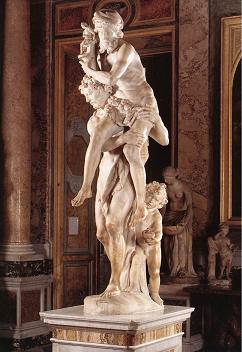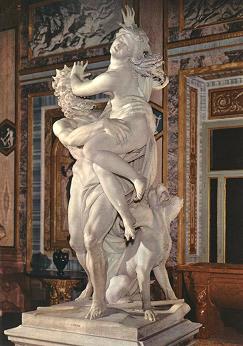|
|
 |
|
Bernini's Sculptures in the Villa Borghese |
|
written
by nmdaybaz / 09.22.2005 |
|
|
| |
Description |
| |
| |

|
| http://www.wga.hu/art/b/bernini/gianlore/
sculptur/1610/aeneas.jpg |
| Aeneas, Anchises and Ascanius Fleeing Troy |
| Bernini (c. 1618-1619) |
| |
|
| |

|
| http://www.wga.hu/art/b/bernini/gianlore/
sculptur/1620/proserpi.jpg |
| Pluto and Persephone |
| Bernini (c. 1621-1622) |
| |
|
| |

|
| http://www.angelo.edu/faculty/rprestia/
1301/images/IN412Bern.jpg |
| Apollo and Daphne |
| Bernini (c. 1622-1625) |
| |
|
| |

|
| http://www.wga.hu/art/b/bernini/gianlore/
sculptur/1620/david.jpg |
| David |
| Bernini (c. 1623-1624) |
| |
|
Aeneas, Anchises and Ascanius Fleeing Troy (c. 1618-1619)
The first of Bernini’s life size sculptures commissioned for Scipione depicts the man Aeneas, the legendary founder of Rome, fleeing Troy while carrying his father on his shoulders with his young son, Ascanius, following close behind. The robust man balances his aging father on his left shoulder, stabilizing him with both hands while his gaze is fixed on the ground ahead, as if carefully watching his steps. The old man steadies himself on his son with one hand while the other hand grasps a family relic above his son’s head. Ascanius is close to his father’s legs with a look of fear in his eyes. Bernini’s father was a Mannerist sculptor, and this influence can be seen in his son’s sculpture. The three generations are arranged in a precarious vertical composition. The group of three figures is centered on a small pedestal, from which Aeneas almost seems to be slipping, which enhances the spiraling movement of the bodies. Both of these characteristics follow in Mannerist tradition. The sculpture is not entirely Mannerist, however; Bernini conveys much more movement in the figures. The action of muscles and tendons can be seen against the skin, and the veins bulge. The skin of the old man is distinctively different from that of his son, as can be seen in the sagging skin and more pronounced veins. These features were not found in Mannerism; rather they were products of Bernini’s own genius and his ability to mold marble as if it were clay. As Howard Hibbard states: “[Bernini] was out of sympathy with the aesthetic aims of Mannerism but was as yet unable to abandon its principles.” The composition was decidedly Mannerism, but the features of the figures themselves were not. This was a transitional piece for Bernini, in which he shed his last attachment with Mannerism from his early training and began creating works in his new realistic style.
Pluto and Persephone (c. 1621-1622)
The next sculpture in the series commissioned for Scipione begins the three great Bernini works of the Villa in which Bernini achieved his new style. The work shows the maiden Persephone being abducted by the god of the underworld, Pluto, and being taken to Hades, past the three headed dog Cerberus who guards its borders. Pluto’s fingers press into her flesh as he holds her to his chest while she pushes at his head in her struggle to escape. The turbulent emotion in this scene pours from the marble. Rudolf Wittkower states: “Bernini interpreted this old rape-theme as a conflict between brutal lust and desperate anguish, emphasizing the contrasting feelings of the two figures by various compositional subtleties…” Persephone’s body twists away from her captor and her face is frozen mid cry with tears running down her cheek. Bernini’s intricate details show movement and struggle with her hair in tendrils flying back from her shoulders. Pluto’s face is slightly distorted as Persephone’s hand pushes at its side. His expression reflects bemusement at her futile struggle, as he is obviously triumphant in his goal- indicated by the presence of ferocious Cerberus as his feet. The three heads of the beast snarl, bearing their precisely carved teeth, with such detail from the swirls of fur on their body to their claws that it looks as if it might come alive. Bernini was a master at being able to convey emotions through marble. Each nuance of the piece contributes to the feelings it portrays: from Persephone’s tears to the way Pluto’s fingers sink into his captive’s flesh. This work was the first of a monumental trio.
Apollo and Daphne (c. 1622-1625)
Bernini based the subject of his next work on the Ovidian tale of the god Apollo and nymph Daphne. Daphne is being pursued in a chase by a love sick Apollo, and just as she is running out of strength she cries out to her father, the river god, to change her form which has caused this problem. The nymph is then transformed into a laurel tree, saving her from her pursuer. Bernini depicts the scene in which Apollo has just caught up to Daphne and reaches his arm around her waist. At the instant that she feels his touch, her body starts transforming into a tree. Apollo observes this transfiguration, and in his expression, one can see his momentary elation being broken by the shock of seeing the subject of his love turning into a tree. His elation itself is false, as his hand only grasps the bark covering her torso. Her fingers sprout intricate leaves as her arms are thrown up in her last effort to escape. Even her body begins to be encased in bark as her toes sprout roots into the ground. The expression carved by Bernini on her face shows her fear of the pursuer who has finally caught up to her. At the same time she seems unaware of her transformation that has Apollo so astounded. Bernini masterfully captures this moment in time. Daphne’s hair is whipped around, even as it begins to sprout leaves, showing her sudden halt from flight at her metamorphosis and capture by Apollo. Even the drapery around the figures is flung around them and trailing out in the space behind them, showing the speed of the chase. Apollo’s right hand steadies him as he runs and reaches out to capture his love. Bernini takes a scene traditionally depicted through literature and painting, and successfully captures the psyches of the characters, as well as the elaborate physical details of each, all to convey this snapshot in mythology.
David (c. 1623-1624)
Though technically this sculpture was completed before the Apollo and Daphne was finished, it was the last to be commissioned in the trio of Bernini’s monumental Borghese works. It is also typically regarded as the final work because it is considered to be the most psychologically advanced of the three statues. This sculpture depicts the biblical character, David, summoning his strength while aiming his slingshot at the giant, Goliath. David’s adversary, however, is not sculpted in this piece, but his stance and intense gaze suggest its presence, prompting the viewer to imagine the towering Goliath. Bernini modeled the facial expression of the David after watching his own expressions in a mirror. Sheer concentration is expertly demonstrated through the tense facial muscles, clenched mouth, flaring nostrils and knitted brow. The figure’s stance is wide, with his toes gripping the ground as he prepares for his shot. A shield and harp at his feet, David’s entire body is twisted to his right, counterbalanced by the turn of his head and position of his arms to face his adversary. Bernini masterfully conveys a scene of great tension and psychological implications through the David, successfully securing proof of his talent at a young age.
|
| |
|
| |
|
|
 |
|




